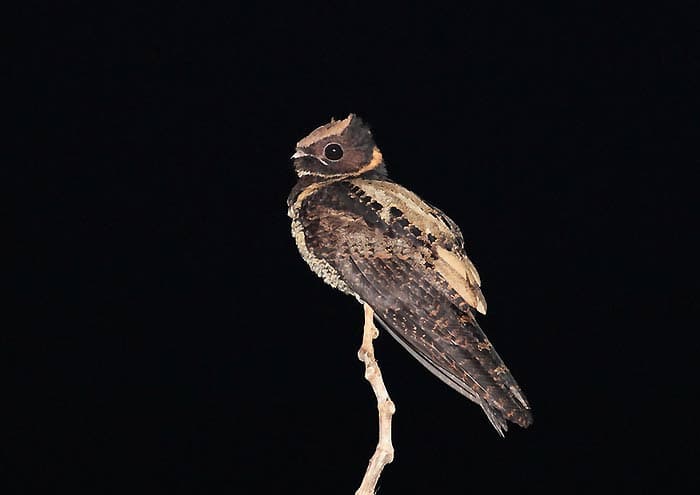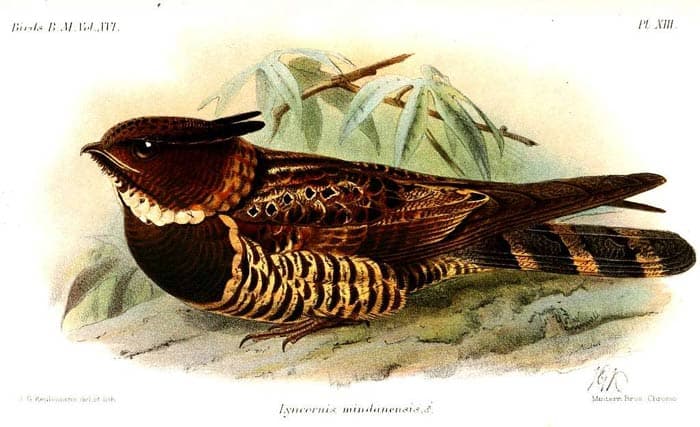
Great Eared Nightjar: In the heart of the night, when the world seems to hold its breath, the Great Eared Nightjar takes flight. This nocturnal bird, known scientifically as Lyncornis macrotis, is a captivating creature that has long intrigued ornithologists and nature enthusiasts. With its distinctive large ears and cryptic plumage, it is a species that embodies the enigmatic allure of the night.
Table of Contents
- A brief overview of the Great-Eared Nightjar
- Importance of studying Great-Eared Nightjar
- Great-Eared Nightjar Scientific Classification
- Physical characteristics and unique features
- Geographical range for Great-Eared Nightjars
- Preferred habitats of Great Eared Nightjars
- What Do Great Eared Nightjars Eat?
- Breeding and Nesting Behavior
- Predators and Threats
- Sounds and Vocal Behavior
- Great Eared Nightjar Conservation Status
- Common Misconceptions of Great Eared Nightjars
- Interesting and Lesser-Known Facts About Great-Eared Nightjars
- Conclusion
A brief overview of the Great-Eared Nightjar
The Great Eared Nightjar is a member of the Caprimulgidae family, a group of birds often associated with myths and folklore due to their nocturnal habits and eerie calls.
- Found predominantly in Southeast Asia, this species has a wide geographical range, extending from India to Indonesia.
- It thrives in various habitats, including forests, plantations, and even urban parks, showcasing its adaptability.
Importance of studying Great-Eared Nightjar
Studying the Great Eared Nightjar is not just about understanding the species itself but also about gaining insights into the health of our ecosystems.
- As a nocturnal insectivore, it plays a crucial role in controlling insect populations, contributing to the balance of our natural environments.
- Moreover, its presence or absence can be a barometer for habitat quality and biodiversity.
- Thus, delving into the world of the Great-Eared Nightjar is a journey into understanding the intricate web of life that sustains our planet.
Great-Eared Nightjar Scientific Classification

The Great Eared Nightjar, or Lyncornis macrotis, belongs to the Caprimulgidae family, a group of nocturnal birds often shrouded in mystery and intrigue. An Irish zoologist, Nicholas Aylward Vigors, first classified this nocturnal bird into the genus Lyncornis in 1831.
- This family is part of the larger order of Caprimulgiformes, including the enigmatic oilbirds and potoos.
- The scientific name ‘Lyncornis macrotis’ is a testament to its most distinctive feature, with ‘Lyncornis’ translating to ‘lynx bird’ and ‘macrotis’ meaning ‘large-eared’, both indicative of its prominent ear tufts[1].
Physical characteristics and unique features
Regarding physical characteristics, the Great-Eared Nightjar is a sight.
- It is a medium-sized bird, measuring about 30-35 cm in length. Its plumage is a mottled mix of browns, greys, and whites, providing excellent camouflage against the backdrop of its nocturnal habitat[2].
- This cryptic coloration is a common trait among the Caprimulgidae, aiding in their elusive nature.
- However, the Great Eared Nightjar’s most striking feature is its large, feathered ear tufts. These tufts, which can be raised or lowered at will, give the bird an almost mythical appearance reminiscent of mythical creatures in folklore. Some have even likened it to a ‘baby dragon’, a testament to its unique aesthetic.
- The bird’s wings and tail are long and rounded, designed for agile flight as it navigates the night sky in search of prey. Its eyes are large and reflective, adapted for its nocturnal lifestyle, while its beak is short but wide, perfect for catching insects mid-flight.
Geographical range for Great-Eared Nightjars
The Great Eared Nightjar, a fascinating member of the Caprimulgidae family, boasts a wide geographical range across Southeast Asia.
- From India’s dense forests to Indonesia’s lush landscapes, this nocturnal bird has known its presence in various environments.
- Its distribution also extends to countries like Sri Lanka, China, Vietnam, Thailand, Malaysia, and the Philippines, demonstrating its adaptability to different climates and habitats[3].
Preferred habitats of Great Eared Nightjars
The preferred habitats of the Great Eared Nightjar are as diverse as their geographical range.
- It is primarily a forest-dwelling species with a particular affinity for primary and secondary forests. These environments provide ample cover and a rich supply of insects, making them ideal for this avian insectivore.
- However, the adaptability of the Great Eared Nightjar extends beyond forested areas. It has been observed in plantations, gardens, and even urban parks, indicating its ability to thrive in modified landscapes.
- Despite its adaptability, the Great Eared Nightjar is predominantly a lowland species, rarely venturing above 1000 meters in altitude. It is also known to favor areas near water bodies, such as rivers and lakes, which often harbor a high density of insects.
- The distribution and habitat preferences of the Great Eared Nightjar provide valuable insights into its ecological role and conservation needs.
- As a species spanning multiple countries and habitats, it is a vital link in the biodiversity chain. Understanding its habitat preferences also aids in identifying key conservation areas and formulating effective strategies to ensure survival.
What Do Great Eared Nightjars Eat?
The Great Eared Nightjar, like its Caprimulgidae counterparts, is an insectivore. Its diet primarily consists of flying insects, which it skillfully catches during its nocturnal flights.
- Moths, beetles, and other night-flying insects form the bulk of its diet[4].
- Its wide, gaping mouth and agile flight make it a formidable hunter in the night sky.
Breeding and Nesting Behavior
Regarding breeding, the Great Eared Nightjar exhibits intriguing habits.
- Unlike many Bird Species, it does not construct a traditional nest. Instead, it lays its eggs directly on the ground, often on leaf litter or bare soil.
- The eggs, usually one or two in number, are cryptically colored, blending seamlessly with the surrounding environment.
- Both parents are responsible for incubating the eggs and caring for the chicks once they hatch.
Predators and Threats
Despite its nocturnal lifestyle and cryptic coloration, the Great Eared Nightjar is not without threats.
- Predators such as larger birds of prey, snakes, and mammals pose a risk, particularly to eggs and chicks. However, the most significant threat to this species is habitat loss due to deforestation and land conversion for agriculture and urban development.
- As human activities continue encroaching upon its habitats, the Great Eared Nightjar faces the challenge of finding suitable environments to thrive.
The behavior and ecology of the Great Eared Nightjar is a testament to the adaptability and resilience of this nocturnal bird. Its unique foraging habits, intriguing breeding behavior, and the threats it faces all contribute to our understanding of its role in the ecosystem.
Sounds and Vocal Behavior
The nocturnal symphony of the forest would be incomplete without the distinctive call of the great-eared Nightjar.
- Like other Caprimulgidae species, its vocalizations are key to its behavior and ecology.
- The primary call of the Great Eared Nightjar is a series of rapid, low-pitched ‘chonk’ sounds, often repeated in quick succession. This call, which resonates through the night, is a signature sound of its habitats across Southeast Asia.
Purpose of their vocalizations
The purpose of these vocalizations is multifaceted.
- Primarily, they serve as a means of communication between individuals, particularly during the breeding season. Males often use their calls to establish territories and attract mates. In response, females may emit softer, more subtle sounds.
- Additionally, the vocalizations of the Great Eared Nightjar can serve as alarm calls, warning other Nightjars of potential threats. This acoustic signaling plays a crucial role in their survival, particularly in the dense, dark environments they inhabit.
Great Eared Nightjar Conservation Status
In avian conservation, the Great Eared Nightjar currently holds the “Least Concern ” status on the IUCN Red List[5]. This classification suggests that, at present, the species is not considered to be under significant threat of extinction. However, this does not mean that it is free from challenges.
Threats and Challenges to Their Survival
Like many wildlife species, the primary threat to the Great Eared Nightjar is habitat loss.
- Deforestation and land conversion for agriculture and urban development are reducing the available habitats for this species.
- Additionally, the use of pesticides in farming can impact their food sources, potentially leading to declines in local populations.
Conservation Efforts
Despite these challenges, efforts are being made to conserve the Great Eared Nightjar.
- Protected areas have been established within its range, providing safe havens for this and other species.
- Additionally, awareness campaigns are being conducted to educate the public about the importance of this nocturnal bird and the need for its conservation.
- The conservation status of this nocturnal bird serves as a reminder of the delicate balance of nature and the importance of ongoing efforts to protect our planet’s biodiversity.
No matter how small or seemingly insignificant, every species plays a vital role in the intricate web of life.
Common Misconceptions of Great Eared Nightjars
- Misconception 1:Nightjars, including the Great-Eared Nightjar, are often associated with myths and superstitions due to their nocturnal habits and eerie calls. They are not omens of bad luck or supernatural beings but simply a unique group of birds with fascinating behaviors.
- Misconception 2:Despite their name, nightjars do not exclusively feed on ‘jars’ or ‘gnats’. Their diet is diverse and includes a variety of flying insects.
- Misconception 3:The Great Eared Nightjar’s large ear tufts are not actual ears. They are feathered extensions that can be raised or lowered at will.
Interesting and Lesser-Known Facts About Great-Eared Nightjars
- The Great Eared Nightjar is one of the few bird species that lay their eggs directly on the ground, often on leaf litter or bare soil, instead of building a traditional nest.
- This species favors areas near water bodies, such as rivers and lakes, which often harbor a high density of insects.
- The Great Eared Nightjar’s call is a series of rapid, low-pitched ‘chonk‘ sounds, often repeated quickly. This call is a signature sound of its habitats across Southeast Asia.
- The Great Eared Nightjar has a wide geographical range, extending from India to Indonesia. It thrives in various habitats, including forests, plantations, and urban parks.
- Despite its nocturnal lifestyle and cryptic coloration, the Great Eared Nightjar faces threats from predators such as larger birds of prey, snakes, and mammals.
- With its unique features and adaptability, the Great Eared Nightjar embodies the diversity and complexity of avian ecology.
- The Great Eared Nightjar is currently classified as “Least Concern” on the IUCN Red List, indicating that it is not currently under significant threat of extinction.
- The most significant threat to the Great Eared Nightjar is habitat loss due to deforestation and land conversion for agriculture and urban development.
- The Great Eared Nightjar is crucial in controlling insect populations, contributing to the balance of our natural environments.
- The Great Eared Nightjar’s presence or absence can be a habitat quality and biodiversity barometer.
Conclusion
In conclusion, the Great Eared Nightjar is a remarkable species that embodies the mystery and allure of the nocturnal world. Its unique features, diverse habitats, and intriguing behaviors make it a fascinating subject of study.
More importantly, as an integral part of our ecosystems, it plays a crucial role in maintaining the balance of nature. Its presence serves as a testament to the health of our environment, while its challenges remind us of the pressing need for conservation. As we continue to explore and understand the world of the Great-Eared Nightjar, we are reminded of the intricate web of life that connects us all.
![]()











